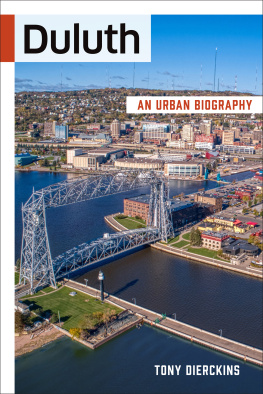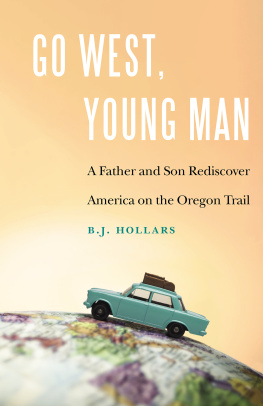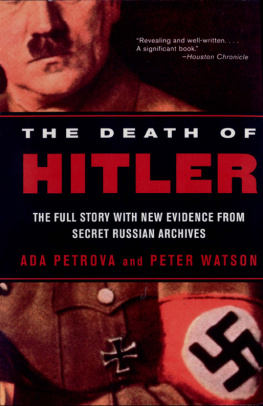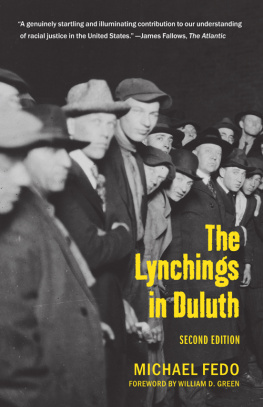Greetings from Duluth:
Essays on Destruction
B.J. Hollars
Dzanc Books
Dzanc Books
5220 Dexter Ann Arbor Road
Ann Arbor, MI 48104
www.dzancbooks.org
Copyright 2014 B.J. Hollars
All rights reserved, except for brief quotations in critical articles or reviews. No part of this book may be reproduced in any manner without prior written permission from the publisher.
Fort Wayne is Still Seventh On Hitlers List, previously published in North American Review, 2011
Fifty Ways of Looking At Tornadoes, previously published in Quarterly West, 2012
Greetings from Duluth previously published in North American Review, 2013
Published 2014 by Dzanc Books
A Dzanc Books rEprint Series Selection
eBooks ISBN-13: 978-1-941531-37-2
eBook Cover by Awarding Book Covers
Four Michael Martone,
who keeps the train on the tracks
the best way out is always through.
-from Robert Frosts A Servant to Servants
CONTENTS
FORT WAYNE IS STILL SEVENTH ON HITLERS LIST
This is a city of poets.
In the 1940s, a poet would tell you that Fort Wayne, Indiana was so wrapped in magnetic wire, superchargers, sonar systems, bombshells, pistons, amplidynes, and dynamotors, that for a brief moment, the people there became important enough to fear obliteration. Employees at General Electric, Rea Magnet Wire Company and International Harvester clocked in seven days a week to support the war effort, churning out all the necessary parts.
Without Fort Wayne, perhaps there would be no B-24 bomber.
Without Fort Wayne, perhaps there would be no atomic bomb.
When Little Boy was dropped over Hiroshima, a small piece of Fort Wayne was lodged inside. On Taylor Street, Joslyn Steel Manufacturing shaped uranium to ingots, contributing to the killing of 140,000 people 6700 miles away.
Days later, when Fat Man was dropped over Nagasaki, once more, Fort Wayne was to blame. Twenty-one year old assistant flight engineer Corporal Robert J. Stock of 415 Downing Streetjust five miles from where I grew uppeered down from his instrument plane at the mushroom cloud ballooning 30,000 feet below.
His mission was to measure destruction, though perhaps the most accurate measurement Stock could ever offer was the knowledge that if Hitler had dropped the same bomb over Fort Wayne, there would be nothing left, not a single steeple piercing the chalk gray sky.
*
A questionnaire from a May 18th, 1942 citywide meeting clarified Fort Wayne citizens questions on how to respond if Hitler bombed the city.
Q. Aside from ordinary fires due to combustion or any other natural source, do you feel there is any danger from fire that we might expect?
A. Yes there is another danger we must face now that we are at war. That danger is from enemy airplanes dropping incendiary bombs.
Q. What is an incendiary bomb?
A. It is a small bomb weighing about two pounds.
They burned at 4500 degrees Fahrenheit.
*
In a coffee shop on Broadway, old men still talk about the planes humming over their city.
Probably twenty or thirty of them, a retired mailman shrugs, sipping his coffee. We had to look up and try to figure out if they were our planes or theirs. We were always waiting for the day when we saw a swastika on the back wing.
That day never came.
With their heads tilted skyward, they spied only skywriters or C-47s droning high above.
The only strike they ever knew was lightning.
In October of 1941, in the months prior to Pearl Harbor, Charles Lindbergh spoke to a crowd of 10,000 at the Gospel Temple on Rudisill Boulevard. His noninterventionist group, America First Committee, was opposed to the American invasion of Europe and Lindbergh looked forward to sharing his feelings with Fort Wayne. The city was proud to host him, onlookers sprawling along the streets and sidewalks to catch a glimpse. But in the early afternoon on December 7th, 1941, as Fort Wayne citizens stepped from their churches and received word of the attack on Pearl Harbor, Lindbergh and his isolationist policy was quickly forgotten. The American First Committee disbanded within days while the men of Fort Wayne rushed to recruiting stations. Six hundred and twelve men who were raised on Wayne Street and Sherman Street and Clay Street would die in places they never knew existed.
A poet will tell you this.
*
My father gets his oil changed at Woodward Tires on Covington Road.
Eighteen bucks for the full service, he says. You cant beat it.
Once, many years back, I attended Lindley Elementary with the owners son. His name was Ryan, and our desks were aligned in the same row, two warplanes in perfect formation. During free-reading period, Ryan and I often hunkered into beanbags that swallowed us whole, taking turns holding The Illustrated Guide to Fossils, pointing out which fossils we would most like to find on our way home from school. We had never heard of any Hitler, nor had we ever been told that Fort Wayne was important enough to make it to the top of any list.
I want to find a trilobite, Ryan once told me, so I said, Okay. I want to find one, too.
Nearly twenty-years later, Ryan Woodward died. Small arms fire from insurgents in Balad, Iraq. He was a corporal. He was a paratrooper. He was no longer in the beanbag chair beside me.
Once, during an oil change, my father asked Mr. Woodward how many tours his son had served. Mr. Woodward didnt speak, just held up three grease-stained fingers.
*
In the coffee shop on Broadway, just a few blocks from General Electric, old men still talk about the German prisoners of wars.
Probably thousands, the retired mailman continues. I was just a little boy then, but we used to sit on my grandmothers porch and wave to them as they jogged by for their daily exercise.
Reports show that by 1945, 600 German prisoners had infiltrated the city.
Camp Scott was originally constructed for the 130th Railroad Battalion, but by 1944, it had transformed to a prison camp. Guard towers were erected, barbed wire rolled out.
The camp was situated just beyond McMillan Park, between Wayne Trace and the Pennsylvania Railroad. The Germans were captured from Rommels Africa Korps before flying into Fort Wayne.
The men at the coffee shop recall Sunday afternoons spent driving past the camp, the prisoners peeking out from the fences. Once the prisoners arrived, some parents no longer allowed their children outside after dark. But some parents did. There are stories of German POWs playing soccer in the park, of children accepting nickels to buy the prisoners sodas from nearby drugstores. The prisoners had access to radios and received more generous beer and cigarette rations than American soldiers overseas. They enjoyed ping-pong. They found girlfriends. They stuck around.
You ask them, theyll tell youFort Wayne is a good place to live.
*
The night after 353 Japanese aircraft attacked Pearl Harbor, the General Electric factory on Broadway turned off its glowing sign for the first time since 1928. The GE symbol had become a stalwart of the Fort Wayne skyline, though the red encircled letters remained dark until wars end. Nine hundred and twenty-five bulbs hummed quiet, and six months later, GE produced its last civilian motor before focusing entirely on war production. Security fences were constructed around the factory, and employees were given high-level identification badges. Armed guards were stationed in guardhouses. The war had reached our backyard.
Nearby, at the Wolf and Dessauer department store on Calhoun Street, the 40,000 lights depicting a glowing Santa and sleigh flickered into darkness as well.
The citizens of Fort Wayne knew one thing for certain:
Next page











